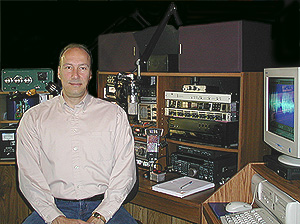
NU9N eSSB Audio News Editorial - January, 2010
|
eSSB Definition Revisited NU9N News Blog - January, 2010 It has been brought to my attention that a debate has arisen regarding technical disputes with the term "eSSB" and "ESSB", and exactly what these terms mean and what qualifies a signal as such. The term "eSSB" was never used or even heard of until I defined and incorporated the term into my website in January of 2003. (See http://www.essb.us/essb_history.html for a detailed account of eSSB history) The table below was included as a guideline for eSSB criteria and designation reference. My choice for using the term "eSSB" (abbreviated for "extended Single Sideband") was simple and straight forward. Extending the bandwidth capabilities of a transmiter will extend the frequency response of the transmitter. And extending frequency response of the transmitter will extend the audio fidelity, because audio fidelity is directly proportional to frequency response with low distortion characteristics. It's all about extension! Even though extension of the frequency response is a form of enhancement, the two terms "Extended" and "Enhanced" are NOT interchangeable. This is because a transmitter with an I.F. filter bandwidth of 2.4 kHz can be "Enhanced" in sound quality if EQ'ed, but can NEVER be extended in bandwidth beyond 3kHz or more. So Why Is 3kHz The Magic Number That Puts The "e" in "eSSB" ? It has been concluded that the minimal baseline, where added fidelity starts to increase with any significance, is 3kHz and beyond. Therefore, eSSB/ESSB (they're both the same by the way) was defined to mean "Extended" RF/audio bandwidth beyond 3kHz, not "Enhanced" (by means of processing) in less than a 3kHz bandwidth. That should be called something else! For years, 2.4kHz and 2.8kHz I.F. filter schemes were employed that kept occupied bandwidth (and the resulting audio) well below 3kHz. Therefore, SSB transmissions that occupy 3kHz or wider is an extension of these old filter schemes and thus refered to as "Extended Single Sideband", i.e. "eSSB". eSSB Examples The table below contains some "Extended SSB" examples and their ITU designators:
Note: The data in the table above are examples ONLY! These bandwidths are NOT set in stone, or meant to be interpreted as multiple eSSB modes. They're all eSSB! The purpose of the table above was to demonstrate how one would identify their transmission in terms of ITU and FCC Part 2-201 standards for emissions. Any bandwidth from 3kHz and above can be used, but it is helpful to know how to identify a given bandwidth using ITU designated descriptions. Even though vocal chord energy diminishes rapidly above 3 kHz, the all important high frequency consonants such as the "S", "T", "SH", "CH" "K" and "Z" that are formed with various combinations of the tongue, roof of the mouth and teeth are well above 3 kHz and essential for high definition speech with less listener fatigue. See the excellent Polycom White paper on: "The Effects of Bandwidth vs. Speech Intelligibility". Based on this research done by Polycom, broadcast white papers, and other credible sources, it has been determined that accurate and articulate speech is poorly represented in audio bandwidths less than 3kHz and greatly improved above 3kHz as bandwidth increases. For this reason, the 3kHz baseline was adopted as a minimum starting point for the extension of available bandwidth. The ITU Designators are reference numbers that are defined by the occupied bandwidth of the signal, as per FCC Part 2-201 standards for SSB emmisions. The Bottom Line Simply put, eSSB/ESSB is ANY SSB transmission that equals or exceeds 3kHz of occupied RF/Audio bandwidth. This is what was in mind from the inception of the term. Any other usage or definition (i.e. enhanced, expanded, etc..) is outside of the scope and purpose for which the term was created. It's too confusing to define eSSB/ESSB with multiple meanings. Admittedly, I have probably contributed to the confusion by incorporating terms like "Lo-fi" and "Mid-fi" on my website, in describing some of the lesser of the eSSB bandwidths. I think is was KC4PE who used these terms and was probably referring to bandwidths that were less than 3kHz. These terms are too subjective and not really applicable to eSSB. Therefore, I am in the process of removing all references of them from my website. Evidently, there needs to be a separate term for processed SSB with less than 3kHz of available RF/AF bandwidth... Perhaps "npSSB" - Narrow Processed Single Sideband" or something similar. I'm sure that someone more creative than me will eventually create one. I wish to stress that the formulation and usage of the term eSSB was never intended to cause division, prejudice, or emotional stress, but rather to implement a logical, non-emotional system of identification, via FCC emission standards, as to better communicate what we were doing technically. No more, no less! I hope this clears up any misunderstanding about eSSB. (Please view the "eSSB" page for additional information) For additional references to eSSB, please visit these links: http://www.nu9n.com/essb.html http://www.essb.us http://www.urbandictionary.com/define.php?term=ESSB http://acronyms.thefreedictionary.com/ESSB 73, -John, NU9N |
|||||||||||||||||||||||||||||||||||||
| John M. Anning - NU9N
e-Mail: |
Home | Intro | About | Rx | Tx | Extended
SSB | AM | Rec/Play | Photos | Feedback | Sites | MP3
Apologetics 1 | Apologetics 2 | Audio Glossary | Donate | eSSB Mods | eSSB Ready Rigs | Transmitter Settings for eSSB
File Downloads | News | Radio Connections | Transmitter Settings | Scope Your Audio | Site Map | Site Search | T-Pad Calculator
Apologetics 1 | Apologetics 2 | Audio Glossary | Donate | eSSB Mods | eSSB Ready Rigs | Transmitter Settings for eSSB
File Downloads | News | Radio Connections | Transmitter Settings | Scope Your Audio | Site Map | Site Search | T-Pad Calculator


